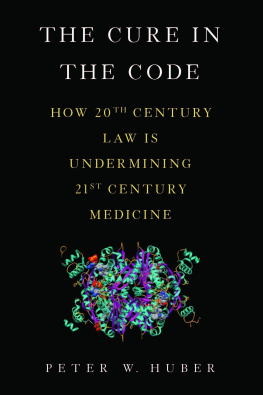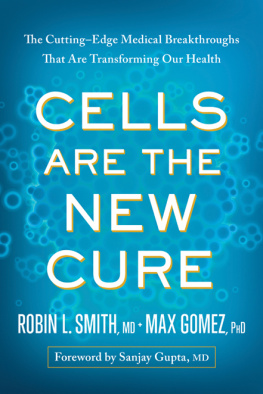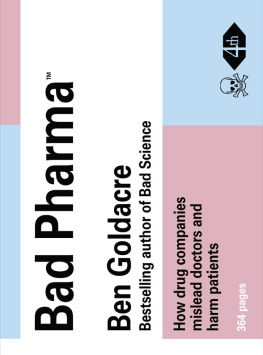SEVERAL CHAPTERS OF this book draw on material previously published in the Manhattan Institutes City journal, Forbes magazine, and Commentary, and I am indebted to the editors of those journals for their input and assistance. Brian Anderson and Ben Plotinsky of the Manhattan Institutes City journal also reviewed the book in its entirety and provided invaluable editorial input throughout. I am grateful for the further editorial assistance I received from Tim Bartlett at Basic Books. Kaitlin Keegan, Jessica Pascoal, and Yevgeniy Feyman provided excellent research assistance. I am, finally, deeply grateful for the patient, unstinting support and help I have received from the Manhattan Institute for Policy Research and its president, Larry Mone.
Also by Peter W. Huber

The Bottomless Well
Hard Green
Galileos Revenge
Liability
THERE HAVE BEEN at work among us three great social agencies: the London City Mission; the novels of Mr. Dickens; the cholera. In The Moral Imagination, historian Gertrude Himmelfarb quotes this reductionist observation at the end of her chapter on Charles Dickens; her debt is to an English nonconformist minister, addressing his flock in 1853. It comes as no surprise to find the author of Hard Times and Oliver Twist honored in his own day alongside the City Mission, a movement founded to engage churches in aiding the poor. But whats Vibrio cholerae doing up there on the dais beside the Inimitable Boz?
Its being commended for the tens of millions of lives its going to save. This vicious little bacterium has just launched the process of transforming ancient sanitary rituals and taboos into a new science of epidemiology. And that science will frame a massiveand ultimately successfulpublic effort to rid the city of a long list of infectious diseases.
Socialized medicines finest hour arrived a century later, on October 16, 1975, by the marshes of Bhola Island, off the coast of Bangladesh. There, in the frame of three-year-old Rahima Banu, the World Health Organization finally cornered smallpox, the most efficient killer on the planet. Then as now, there was no known cure for the highly contagious disease, but vaccinating others on Bhola Island kept the virus from skipping to new human hosts, and little Rahima was the last one left.
In the 1960s, at the height of the Cold War, the Soviet Union and the United States had joined forces under the aegis of a United Nations affiliate to beat the disease. Over the course of the next two decades, they bought billions of doses of vaccine, deployed tens of thousands of workers, mobilized national armies to isolate infected regions, prohibited public meetings, quarantined hotels and apartment buildings, dispatched helicopters, airlifted refrigerators, sent in doctors and nurses, established rings of immunity around newly infected areas, and then tightened the rings until only one ring surrounding one little girl remained. And she, standing tiny but tall, finished off the most virulent strain of the virus on her own.
America underwrote much of the global war on smallpox and helped save hundreds of millions of lives worldwide, and because we no longer have to protect ourselves against smallpox, Americans today save as much every month in direct and indirect societal costs as their grandparents spent on the entire smallpox campaign. According to estimates made in 1994, every dollar spent on polio vaccine saved about five times as much in such costs. The measles immunization payoff was thirteen to one. In 2001, every dollar spent on immunization with five widely administered vaccines was saving an estimated $6 in direct medical costs and another $12 in costs of missed work, disability, and death. Socialized medicines hundred-year war against germs did far more to improve human health and extend life expectancy than all the rest of medicine developed before or since.
But these triumphs of socialized medicine are behind us now. The medical future looks nothing like the medical pastthe diseases are different, and so are the cures. While medical science moved on, Washington dug in. Our medical-regulatory complexa briar patch of scientific and economic proscriptions, mandates, subsidies, and patents, plus one strange, little-known, but extremely important form of copyrightremains rooted in the scientific methods and public policies that coalesced between 1853 and the early 1980s. These policies, as outlined briefly in this chapter and discussed throughout the rest of the book, were designed to regulate ignorance, not knowledgethe dearth of molecular medical science, not the science itself, nor its efficient, orderly development.

POUND FOR POUND, bacteria, viruses, and other microbes contain far more intelligence than we do. They are the closest nature gets to pure code. They are also the most ancient, nimble, creative, and persistent developers of new code on the planet. They have survived planetary catastrophes ten thousand times longer than creatures like us have walked the earth. They probably outweigh all the rest of life combined. They thrive under the arctic permafrost, alongside thermal vents at the bottom of the ocean, under miles of rock, and most everywhere else on or anywhere near the earths surface. Our own bodies host an estimated ten germs for every human cell.
A fistful of germs that specialize in dining on people evolved over the course of three thousand years of urban human history. These legacies of the distant medical past developed a molecular peg that fits neatly into some molecular hole that many of us share. Quite a number of them also found some ingenious way to provoke the sneeze, the violent diarrhea, or even the lustful itch that helps the germ spread. The cholera bacterium, for example, persuades cells in your gut that youve eaten a dangerous amount of salt, which must be flushed out with water sucked from your body.
Germs discovered the joys of socialism long before we did, and in health matters made communists of us all. An epidemicfrom the Greek meaning upon the peoplewas the democracy of rich and poor incinerated indiscriminately by the same fever, or dying indistinguishably in puddles of their own waste. The crowded city served as septic womb, colony, and mortuary.
Smallpox was the Mao of microbesit killed three hundred million people in the twentieth century alone. Sometimes called the first urban virus, it probably jumped from animals to humans in Egypt, Mesopotamia, or the Indus River Valley at about the same time that the rise of agriculture began drawing people together in towns and cities. Smallpox has also been called natures cruelest antidote to human vanity. Princes broke out in the same pustules as paupers, reeked as foully of rotting flesh, and oozed the same blackish blood from all their orifices. Alongside millions of nameless dead lie kings of France and Spain, queens of England and Sweden, one Austrian and two Japanese emperors, and a czar of Russia.
When monarchs were dying alongside peasants, the language and politics of health and disease honestly tracked medical reality. The main threats to the public health threatened everyone. They also pointed to a compelling need for collective solutions. Disease was caused by invisible, external agents that individuals couldnt control on their own. We were all in the same us-against-it battle to the death. (Though the arrival of the invisible it was often blamed on foreignerssyphilis was the French disease for the English, la maladie anglaise for the French, the Polish disease for the Russians, and the disease of the Christians for the Arabs.)
Next page








